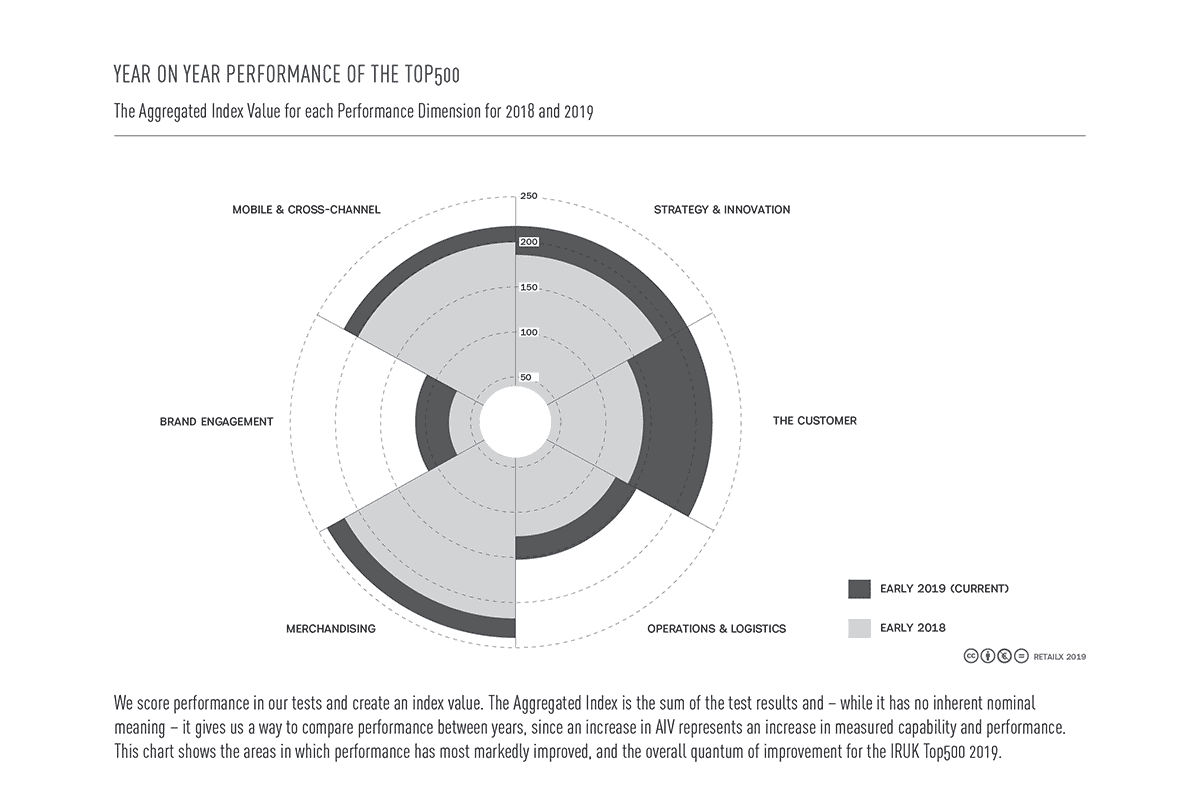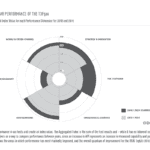Thinking across channels
Leaders in this field offer joined-up services, from start to finish of the shopping journey
The retailers that stand out in the IRUK Top500 Strategy & Innovation Dimension deploy new techniques and services to offer shoppers a flexible and convenient shopping experience – however they choose to buy.
These traders get ahead of the crowd by innovating, and they maintain that leading position by consistently building on their performance, developing services that work to join up their sales channels, and to improve the way that channels and sales processes operate.
RetailX researchers assessed Top500 retailers against more than 30 wide-ranging metrics that they consider strategically important and which take the customer from the beginning to the end of the shopping journey. That starts with judging availability and quality of service across different channels – how quickly it loads on mobile and on desktop – and whether a retailer offers an Android or iOS app.
Next, researchers judged how easy it was to find a product on the website, using search and navigation tools and assessed the level of personalisation present in recommendations. Merchandising metrics such as how the quality of product information and the number of product images illustrate how easily customers can see whether an item is the right one for them.
Retailers’ responsiveness to customer queries if assessed through its use of social media and other communication channels. The research concludes the shopping journey at the point of delivery, collection and return, assessing how easily a shopper can first take possession of the item, and potentially return it if necessary.
Innovative services included same-day delivery and collection, as well as visual search.
What the Top500 do
Top500 retailers win their place in the index by delivering a well-thought out shopping experience to their customers. Here we take a look the tools they use in order to do that, starting with the speed with which their websites load.
Desktop websites were visually complete in an average of 9.9s, while mobile websites were visually complete in an average 9.2s. Among the retailers whose mobile websites were measured both in 2017 and 2018, visual completion took 14% longer in 2019 (8s) than in 2018 (7s), while page sizes, measured in bytes, increased by 27%. Shoppers spent an average of 325 seconds – or 5.4 minutes – on a Top500 website, and a median of 289s – or 4.8 minutes.
Retailers enabled shoppers to get in touch via an average of 9.5 communication channels – from email and by phone to a range of different social media platforms. On Twitter, shoppers had an average of 219,000 followers: larger retailers have much larger followings however, since the median number was just over 30,000.
Considering how easy retailers made it for shoppers to find an item on their mobile website, 58% offered autocomplete dropdown suggestions when shoppers searched, while 82% had the hamburger button – the three-line navigation aid that makes it easier to get around mobile websites. That was down from 93% last year but remained the clear standard.
At product-level, shoppers could view an item through an average of 3.8 images on a desktop website, and four images on a mobile website. More than half of retailers (59%) enabled shoppers to zoom in on product images. Cross-selling, by recommending similar products, was offered by 71% of retailers. Well over half (59%) enabled shoppers to save items to a wishlist.
Almost half of retailers (47%) had an iOS app, slightly more than the 45% that had an Android app.
Across the Top500, 58% of retailers offered next-day delivery. Of the retailers that offer delivery and that were included in the Top500 both this year and last year, 59% offered next-day delivery in 2019, up by six percentage points from the 53% that offered it in 2018. The proportion of retailers offering same-day delivery stayed in line with last year, at 5%, while 16% offered nominated day delivery – up from 14% last year – and 7% offered nominated time. Almost a third (30%) offered Saturday delivery, while 13% offered Sunday delivery.
Well over half (60%) of Top500 retailers also offered collection, and 11% offered same-day collection. While the proportion of retailers offering collection stayed flat, compared to last year, those offering same-day collection was significantly down. Of those retailers that offered collection in both years, 21% offered a same-day service last year, compared to 14% this year.
Among those offering collection, items were ready to pick up in an average of three days from the time of delivery, a figure that stayed the same as last year. Only 1% of Top500 retailers enabled shoppers to collect from their own lockers in their store, or another store, in 2019: that’s down from 2% last year. Some 49% enabled shoppers to return an item bought online to the store, while 16% enabled them to return an item via pick-up from the house.
What leading retailers do
Argos and Tesco both stood out in the research for comprehensive delivery and collections services. They both offered services that most retailers did not, including same-day delivery and collection, as well as nominated time delivery.
Next combined a flexible delivery and collection promise, that included same-day delivery and collection as well as nominated time delivery, with a highly innovative visual search capability.
Debenhams stood out for a flexible delivery offer – which included nominated time and day options – and for the way it in which it made it easy for shoppers to find the items they wanted to buy, through tools including a store stock checker and predictive search on the Debenhams mobile app.
A varied range of cutting edge services helped to keep Amazon ahead: customers could collect from its own collection lockers or opt for same-day delivery. They could also use visual search and live chat to aid their shopping mission.
Fashion retailer H&M also offered visual search and predictive search, as well as a barcode scanner in its mobile app. It also stood out for offering returns via pick-up from the house.
B&Q’s range of flexible services included returns via pick-up from the house, nominated day delivery a store stock checker and predictive search.
A robust customer journey from health and beauty retailer Boots included nominated day delivery and same-day collection. It had an Android app, and offered predictive search through its iOS app.
Halfords made it easy for shoppers to find the products they were looking for from its app, where it had a store stock checker, a barcode scanner and offered predictive search and daily deals.
Sainsbury’s had a strong delivery promise – including same-day, nominated time and nominated day delivery. It also offered predictive search in its mobile app.







